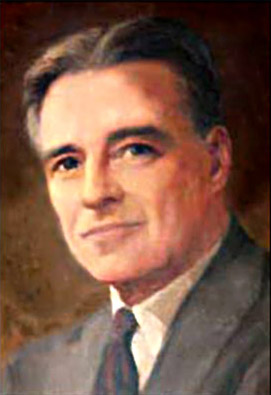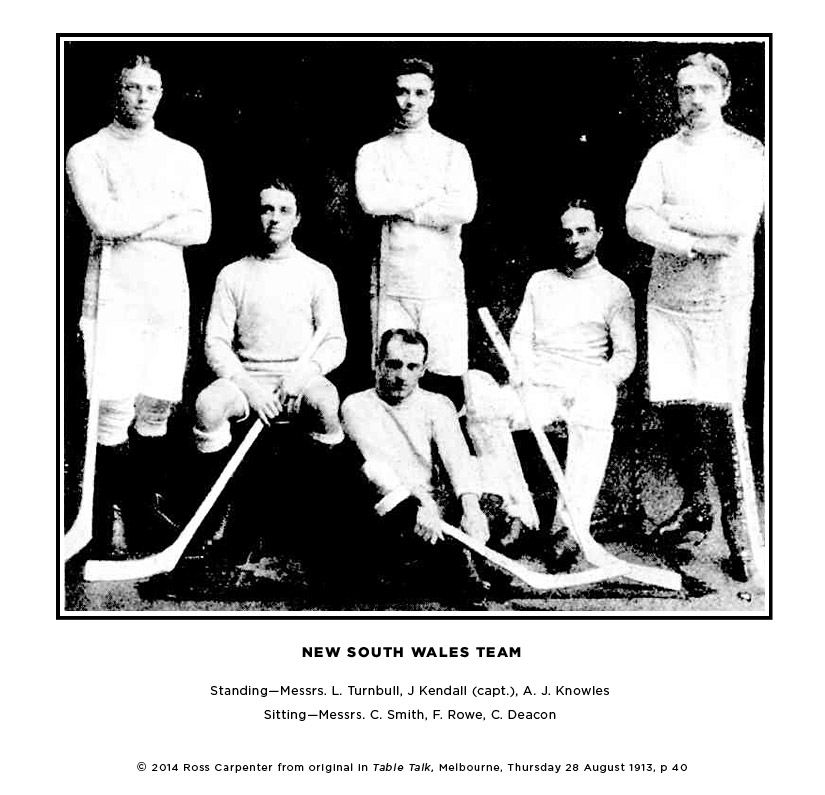CAREER SUMMARY
Birth
13 December 1889
Sydney NS Canada
Death
1942 (53)
Sydney NSW Australia
Clubs
Maritime Hockey League NS, Sydney Glaciarium Corinthians, NSW Eastern Suburbs
Goodall Cups
1911, '12, '21, '23
Life Membership
First life member of NSW Association (lapsed, record extant)
Coached Ken Kennedy and Jim Brown (hockey and speed skating)
Foundation Captain of Eastern Suburbs
State team coach, later a selector
Namesake of the AIHL Finals MVP Trophy
BORN FRIDAY 13th IN DECEMBER 1889 at Sydney, Nova Scotia, the only son of Ida and Henry who became Lieutenant Governor of Nova Scotia in 1942. He first developed hockey skills in Sydney NS — in the amateur Maritime Hockey League (MHL) operating in Nova Scotia around 1900, and perhaps even its forerunners. It was the first of the early recognized pro leagues formed from the Interprovincial Professional Hockey League 1910–11 season. He was 19 years old when the amateur IPAHU was founded and it has been said he was offered a cadetship with the "Montréal Professional Club" in Montréal, Québec, the largest city in Canada at the time. He left Canada for Australia, where amateur ice hockey had only just begun, and pro hockey did not exist at all.
"He decided he'd see the world so he took a tramp steamer," said a friend of his sister in Sydney NS in 1996. "He found himself in Cape Town and he didn't have any money and he wore his pajamas on the boat. That was his garment on the boat because he was saving his suit for the land. Anyway, he put on the suit and hitched a ride, he wanted to see the diamond fields in South Africa because the tramp steamer was going to be in for a few days, so he had a two or three days off. So he got on this train, and this was quite an offense in South Africa, and he got put in jail and he was desperate ... but he got out and on to the boat and went to Australia."
Then a 19 year-old salesman he arrived in Sydney via Melbourne on June 26th, 1909, the year the Goodall Cup was first contested although, according to the official record, he did not play until two seasons later. He regularly commuted 160 km between Newcastle and Sydney to start game play at 10.15 pm, then returned on the 'Paper Train', as it was commonly known. He played his first game for NSW in 1911 at the age of 22 and he also played on the 1912 and 1913 NSW teams.
Ice hockey in Australia by this time was conducted according to McGill Rules (1879) introduced in Melbourne by 1908, and although Victoria assigned two rovers to tag him, it made little difference. The Cup left Victoria for the first time in 1911 when he played his first game, remaining in NSW for two years. He was instantly regarded as the best ice hockey player in Australia for years thereafter.
The Victorian Interstate Hockey Programme in Melbourne in 1932 reported concern among the Victorians from the time of the first NSW practice session: "Jim he caused consternation and amazement with the Victorian players and selectors by his amazing speed, accuracy and powerful shooting and was virtually a match on his own for the Victorian team." He revolutionised NSW ice hockey through his Canadian training and ability, but Victoria still took the interstate honours 2-1 in 1913, winning the Cup back. In Sydney the same year, he married Hilda Mary Dibbs. Hilda became "a Baroness or something or other, a great socialite in Sydney, Australia" when she remarried after his death.
He was appointed BHP's Chief Mechanical Engineer after he returned from Canada during the war. His future business partner, BHP metallurgist Leslie Bradford, was transferred to their Newcastle steelworks the year it opened. He, Bradford, and a group of friends, punted on the horse, rolling-over their bets on five straight wins between 1919 and 1920. By January 24th, 1920, they had won a small fortune of 15,000 pounds. He and Bradford both resigned from BHP and used their winnings to establish a steel foundry in Alexandria, Sydney. He was Managing Director when Bradford Kendall Ltd was registered as a public company in 1922.
Today, the company is Bradken; Australia's largest combined foundry and heavy engineering group and one of the leading ferrous-casting companies in the world. From its corporate office in Newcastle, it operates 18 specialised manufacturing facilities and five businesses throughout Australia, New Zealand and the United Kingdom with a 2,800-strong workforce.
He resumed his hockey career when Sydney Glaciarium re-opened in 1920. It has been said his coaching gave New South Wales a distinct advantage over Victoria and he coached such notable players as Jim Brown and Ken Kennedy. He was a foundation captain of the NSW Eastern Suburbs Ice Hockey Club. Interstate games resumed the next year and New South Wales won the Goodall Cup. Victoria won it back the year after in 1922, then New South Wales dominated, perhaps winning fifteen of the seventeen contests between 1923 and 1946.
In 1924, the season before he retired, his Eastern Suburbs again won the New South Wales ice hockey premiership and the Hamilton Trophy. He won the Tintex Cup for the highest scorer with 18 goals, half the total his team scored that season. The manager of the Studebaker factory in Detroit and Cleveland visited here that year and said he was "the equal of any of the American or Canadian players."
In 1926, he retired at 37 years of age, but he continued to coach for some years. In 1937, at the age of 48, he returned to coach the new Sydney University Ice Hockey team in the reserve grade showing "that he has lost none of his skill in handling the puck". This club had been formed with members of the four senior clubs who attended the University. The state association hoped it would develop into a fifth senior club and, although it performed credibly, it disbanded in 1938.
He was elected the first life member of the NSW association although he is no longer listed on the honour roll. He was also an accomplished yachtsman and competed regularly in 13 ft and 16 ft skiff racing on Sydney Harbour. He was 1924-5 State champion in Iris on Lake Macquarie, and a cup at Port Jackson club was named after him early 1930s. These skiffs are unique in the world and peculiar to Australia.
His son Bill was a Harvard graduate who represented Australia in 100 metres freestyle swimming at the 1936 Berlin Olympic Games and married Australian figure skating champion Betty Maxwell. He died in 1942, the year his son married; the year his 78-year-old father became Lieutenant Governor of Nova Scotia, and moved into Government House, the oldest vice-regal residence in North America. To perpetuate his memory, a trophy was presented in 1949 by former NSW association president, Harold Waddell Hoban and Ken Kennedy's father, Jack. Once awarded to winners of the inter-rink matches between Sydney's Glaciarium and Ice Palais teams, it has since ceased to exist. The AIHL Finals MVP trophy was named in his honour.
[1] Henry Kendall was Lieutenant Governor of the Province of Nova Scotia between November 17th, 1942 and August 12th, 1947; long after his son had left Canada. In fact, Jim died the year of the appointment, so he may not have even heard. Henry was age 78 when sworn in, the oldest to hold this office in the history of Nova Scotia, and one of the oldest in all of Canada. Lieutenant Governors are Royal representatives appointed by the Governor General on the recommendation of the Prime Minister of Canada and the Federal Cabinet. He lived in Government House at Halifax, the oldest vice-regal residence in North America, for almost five years. His political career had commenced at least twenty years earlier, when on June 12th, 1921, he was an unsuccessful Progressive Party candidate for the Federal Riding of Hants, Nova Scotia, in the 14th Parliament. [67]He was succeeded as Lieutenant Governor by John Alexander Douglas McCurdy (1886-1961), the first person to fly an airplane in Canada and a founder of the Royal Canadian Air Force. Henry Kendall died two years later at the age of 85 in Windsor, NS. He was interred with his first wife Ida, brother Arthur, and mother Emily at Hardwood Hill Cemetery, Sydney, NS. [68]
[2] Jim Kendall's uncle, Arthur Samuel Kendall (March 25, 1861 – July 18, 1944), was a physician and political figure in Nova Scotia like his brother. He was a Liberal member representing Cape Breton in the Canadian House of Commons from 1900 to 1904. He graduated from Mount Allison College in 1879, Halifax Medical College in 1881, and Bellevue Hospital Medical School in New York in 1882. He was certified as a Member of the Royal College of Surgeons from Guy's Hospital Medical School in London, England in 1884 and returned to Sydney to establish a medical practice later that year. [73] His younger brother Henry, Jim Kendall's father, was also a practising physician and may have attended some of the same schools. But it was Arthur's time in England that enabled him to see in advance the effects of industrialisation, which in turn shaped his reformist agenda. Arthur served as a town councillor for Sydney in 1888 and ran unsuccessfully for a seat in the House of Commons in 1896. He represented Cape Breton County in the Nova Scotia House of Assembly (MLA) from 1897 to 1900 and from 1904 to 1911. [63] Arthur's association with Cape Breton coal miners built his reputation as the "miners friend'' and someone "for whom the miners had great affection". He did not appear to care unduly about personal wealth or physical appearance. The County of Cape Breton 1979 Centennial Booklet contains a photograph of an elderly Arthur Kendall, unassuming and kindly, wearing a cloth cap and a tattered fur coat that is strapped around his chest and waist, with two stout leather belts — displaying an obvious "unconcern for his sartorial condition." [77]
[3] Simon Fraser (1832–1919), grandfather of former Prime Minister Malcolm Fraser, was born in Pictou, Nova Scotia (map at link above). He grew up there and immigrated to Australia in 1854 at the age of 22, where he bought extensive estates in the Western District of Victoria. There he became a leader of the wealthy wool-growing class known as the squatters, which included the Armytage family. Fraser was elected to the Victorian Legislative Assembly for the seat of Rodney in 1876 where he served until 1883. He was elected to the Victorian Legislative Council, the traditional preserve of the squatters, for South Yarra Province in 1886, and remained a member until 1901. He was a Minister without Portfolio from 1890 to 1892. He was a Victorian delegate to the Imperial Conference in Ottawa, Canada in 1894. Robert Reid, uncle of Henry Newman Reid, was also in Ottawa in May 1894. Reid had arrived the year before, the year Lord Stanley donated the Stanley Cup (see Henry Newman Reid). Fraser was a member of the Constitutional Convention which drafted the Australian Constitution and he was closely related to the family of John Goodall.
[4] Known links between members of the NSW Ice Hockey Association and NSW horse racing at this time include Kendall and W Nicholson; Jimmy Bendrodt (1891–1973), racehorse owner and manager of the Sydney Ice Palais. In 1920, Bendrodt may have been patron of Glaciarium Ice Hockey Club in 1920, the earliest forerunner of the NSW Association. Kendall resumed playing that year and he is on record in 1923 as attending the Association meetings. [2] Bendrodt may have been part of Kendall's racing circle. Bill "Midge" McLachlan (1889 – 1967), who rode Jack Findlay in 1920 and catapulted Kendall and Bradken to success, was great-grandfather of the Freedman brothers. Midge was one of the most acclaimed jockeys of his time. His feature wins included three Melbourne Cups, two Caulfield Cups and two Sydney Cups, and he is widely (though wrongly) celebrated as the first Australian jockey to ride for the royal family in England. In fact, that distinction belongs to his son, William Henry McLachlan (1908 – 1964) or "Young Bill," who died at Randwick in 1964.
Ross Carpenter, 'Kendall, Jim (1889 - 1942)', Legends of Australian Ice, Melbourne, Australia, http://icelegendsaustralia.com/legends-2/bio-kendall.html, accessed online May 16, 2025.



